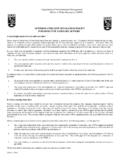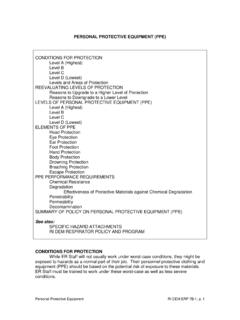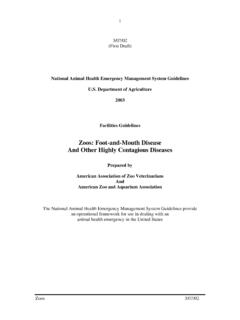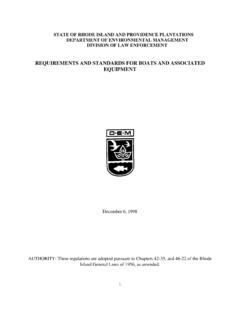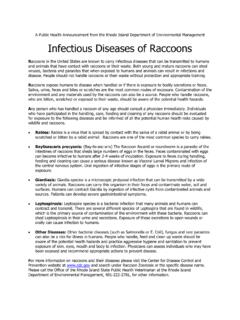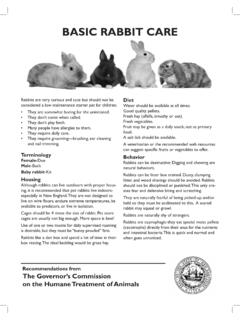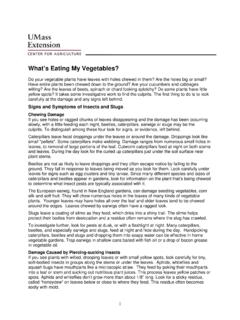Transcription of Cottontail Rabbits in Rhode Island
1 Cottontail Rabbits in Rhode Island Description: There are two types of Rabbits that inhabit Rhode Island , the Eastern (Sylvilagus floridanus) and New England (Sylvilagus transitionalis) Cottontail Rabbits . The Eastern Cottontail is an introduced species whereas the New England Cottontail is a native species. The Eastern Cottontail was first introduced into Rhode Island during the early 1900s to supplement the declining New England Cottontail populations. Cottontails have longs ears, large hind feet, and short, fluffy tails. The coloration of the coat can range from reddish-brown to black to grayish-brown while the undersides are white. Eastern and New England cottontails look almost identical except for a slight variation in their coat colors. About half the population of Eastern cottontails possess a small white spot on their foreheads whereas the New England cottontails have a small black spot on their foreheads. Eastern and New England cottontails have slightly different body weights as well.
2 The Eastern Cottontail weighs on average 2-4 pounds and has a total body length ranging from 15-18 inches. The New England Cottontail weighs pounds on average and has a total body length ranging from 14-19 inches. The males are called bucks and the females are called does. Rabbits are considered lagomorphs not rodents. Lagomorphs are an order of small mammals that include pikas, Rabbits , and hares. The main difference between the two is that lagomorphs have two pairs of upper incisors whereas rodents only have one pair. Another difference is that all lagomorphs are strictly herbivores (eat only vegetation) unlike rodents who are omnivores (eat both vegetation and meat). Cottontail Rabbits have distinguishable tracks. They leave behind a 3 x 1 inch long hind foot tracks, which can be seen in front of the smaller, 1 x 1 inch, front foot tracks.
3 The feet are typically six inches apart and spaces between sets of tracks are a few feet apart. Rhode Island is not only a host to cottontails but to the snowshoe hare (Lepus americanus) as well. Snowshoe hares however, are not nearly as common as the two Cottontail breeds. Hares and Rabbits are very similar but they have distinguishable differences. One of the main differences is that snowshoe hares have larger back feet than Cottontail Rabbits , due to their larger hind feet they are able to sprint across slippery surfaces. Another difference is the coloration of their coats. Snowshoe hares change the color of their coats twice a year, during the summer they possess brown fur and during the winter their coat color changes to white, which helps them blend into their surroundings. Snowshoe hares also differ from Rabbits in their habitat requirements.
4 Snowshoes prefer living in northern climates, where there is near-constant snow cover during the winter, whereas cottontails prefer more temperate zones with less snow cover. Another key difference is that the young of snowshoe hares are born alert and covered with fur unlike the young of cottontails who are born helpless and hairless. This difference may occur because hares and cottontails have different nesting sites. Cottontails nest in areas that are hidden from predators whereas hares nest in open areas, which are visible to other animals. Eastern Cottontail Snowshoe Hare New England Cottontail Life History: Cottontails live in a variety of different habitats. Both breeds can be found most often in open fields, fencerows, forest edges, barrier beaches, the borders of marshy regions, and areas of thick cover.
5 They also show a preference for areas nearby a water source, such as a creek, pond, or stream. Rabbits that inhabit backyards are most likely Eastern cottontails because New England cottontails favor open woods and shrub thickets. The mean for a doe s range is between five to 15 acres, while a buck may have a range up to 100 acres. The Eastern Cottontail can be found throughout the entire United States east of the Rocky Mountains. The New England Cottontail , as it name suggests, can be found in parts of all New England states, except Vermont, and it is also can be found in eastern New York. Rabbits are herbivores, meaning they only eat plant and other fibrous materials. During the spring and the summer they typically feed on wild grasses, clover, buds, sprouts, and shoots of alfalfa, beans, peas, and dandelions. During the autumn and winter, their diet may consist of buds, stems, and the bark of sumac, red maple, apple, and birch trees. Rabbits also practice copraphagy; they re-ingest their own fecal pellets to increase their absorption of vitamins and minerals.
6 rabbit fecal pellets are spherical and dark brown when fresh, unlike deer droppings, which are cylindrical and have one pointed end. Cottontails are prolific breeders; they usually have 2 3 litters per year and give birth to their first litter during the early spring. The gestation time for a female rabbit is about 28-30 days and she can be mated right after giving birth. The average litter size is five but can range from two to eight progeny depending on geographical location and food availability. The young are born hairless, blind, and deaf. At the time of birth, the young weigh on average, one ounce and measure four inches in length. The babies are weaned at about three weeks of age and then leave the nest. Many of the young do not survive due to predators and disease. They are considered fully mature at four months of age. Rabbits do not dig their own burrows, young are born in shallow depressions made in the ground that are about six inches deep and six inches wide.
7 The nest is lined with dry grass and foliage as well as fur from the doe s body. Cottontails will use burrows excavated by other animals or other natural cavities during inclement weather or as a means to escape predators. Rabbits are preyed upon by a wide variety of predators such as coyotes, foxes, fishers, mink, and raptors. Disease: Rabbits are a host to a variety of parasites and diseases. Most of these diseases are not dangerous to humans. A disease that Rabbits occasionally contract is tularemia. This disease is found in both rodents and Rabbits . It is caused by a bacterium and transmitted by ticks or fleas and it is always fatal to Rabbits . It is a potentially serious illness in humans and can spread from infected animals to humans by handling of infected animal carcasses, being bitten by an infected tick or breathing in the bacteria contained in dried droppings. Though rabies may infect any mammal, it is not commonly found in Rabbits .
8 Damage Identification Rabbits can cause damage to vegetable gardens, landscape plants, and orchards. The most common complaint against Rabbits is that they are garden pests. In the spring and summer, when a garden is flourishing they will feed upon the growing vegetables and flowers. They are particularly fond of young, newly sprouted carrots, spinach, lettuce, broccoli, and cabbage. They are also known to ruin woody plants by gnawing on the bark or clipping of the branches, stems, or buds. Rabbits have uprooted incisors (front top teeth) that continuously grow throughout their lifetimes. Their incisors allow them to gnaw on the tree bark as well as clip the sprouting buds. Rabbits leave behind a knifelike slanting cut on the twigs and buds they clip for food, they do not leave any apparent teeth marks behind. Deer on the other hand, lack upper incisors, they must grab and pull off the vegetation they want to consume, therefore, the ends of the shoots and branches they grasp at are jagged.
9 Rabbits can cause damage to landscape plants, orchards, forest plantations, and park trees due to their gnawing and clipping tendencies.. The angled clean- cut on this stem is caused by a rabbit or hare using their upper incisors to clip the stem. Deer cause the ends of stems and twigs to have a jagged appearance since deer snap off vegetation using their upper pad and lower incisors Damage Prevention: One of the most effective ways to protect your garden from Rabbits is to put up a fence. A two to three foot tall fence can effectively keep Rabbits and other animals out of the garden. Popular fence choices include chicken wire, wire mesh, chain link, or welded wire fences. Fencing large gardens might be somewhat expensive; however it will be a long lasting solution to the problem. Chemical repellents are another option to ward off Rabbits . Typically, odor or taste repellents are applied to the plant, as a dust or spray. The treated portion of the plant is distasteful to the rabbit .
10 Once they ingest part of the treated plant they will get an urge to regurgitate and never attempt to eat the plant again. Many commercial taste repellents contain fungicides. Some also contain capsaicin, which is derived from hot peppers. Odor repellents may also be used to ward off the Rabbits . If they sense a foul unfamiliar smell they will back off from the territory. Dried blood meal is an effective odor repellent. The disadvantage in using repellents however is that they must be reapplied after it rains and they only treat part of the plant. There are no toxicants or fumigants registered for use against Rabbits . The user should follow product label instructions because some repellents cannot be used on plants that are meant for human consumption. Another alternative is modifying the habitat. This can be achieved by mowing the lawn, removing brush piles and weed patches. Rabbits like to hide and live in long grass, by mowing and removing foliage; the Rabbits will be less apt to make their homes in the backyard.

